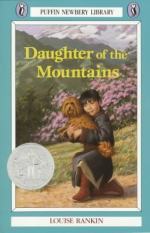|
This section contains 996 words (approx. 3 pages at 400 words per page) |

|
Point of View
The point of view of Daughter of the Mountains is third-personal. The book is written only from the perspective of an outside observer. However, one might describe Daughter of the Mountains as taking a third-personal perspective with first-personal elements. The author focuses exclusively on the thoughts of Momo and it is only inside of her that the reader can regularly peer. Readers rarely see the thoughts of others described, but descriptions of Momo's thought life are rich. The third-personal perspective often appears omniscient but is restricted mostly to what Momo experiences. It is what Momo hears and sees that the author describes. The reader is occasionally faced with reactions from those around her that she cannot understand, such as when Gopal is communicating to the Lady Paton in a way that Momo cannot understand. When Momo calls Pempa, for instance, the author describes Pempa's reaction though...
|
This section contains 996 words (approx. 3 pages at 400 words per page) |

|




